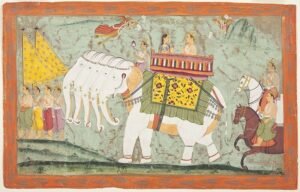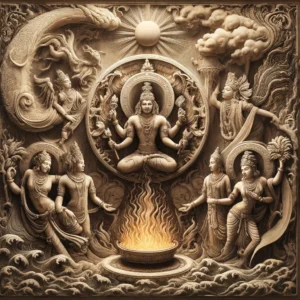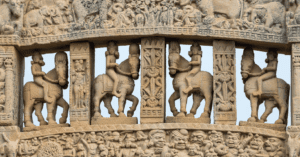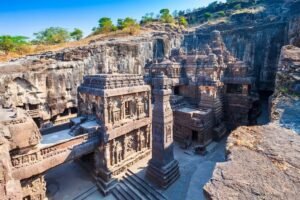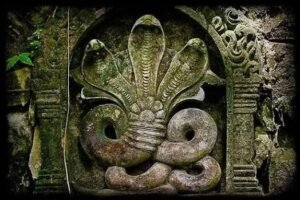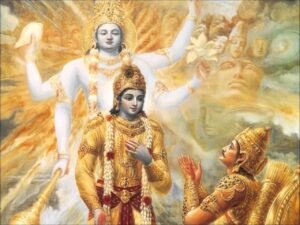Hinduism is the world’s oldest continuously practiced religion, deeply embedded in the culture and history of the Indian subcontinent. Unlike many other religions, Hinduism has no single founder, and it is more of a way of life or philosophy that evolved organically over thousands of years. Today, it remains a vibrant and diverse faith, influencing art, culture, and philosophy globally.
In this guide, we will explore Hinduism’s origins, core beliefs, schools of thought, sacred texts, important figures, rituals, and sacred pilgrimages from the north to the south of India. This is designed to be a comprehensive introduction for those beginning to explore Hinduism or looking to expand their knowledge.
1. Origins and Evolution of Hinduism
Hinduism is deeply rooted in the Indian subcontinent, with its origins dating back more than 4,000 years. It emerged from the spiritual traditions of the Indus Valley Civilization (around 2500 BCE), one of the world’s oldest urban cultures. Early forms of worship involved reverence for nature, animals, and a proto-Shiva figure, which were later absorbed into the broader Hindu pantheon.
Over time, Hinduism has evolved through various stages, from the early Vedic traditions to the more philosophical and devotional practices that characterize modern Hinduism.
Historical Context:
- Indus Valley Civilization (c. 2500 BCE – 1500 BCE): Archaeological evidence, including the Great Bath of Mohenjo-Daro and seals depicting deities, points to early religious practices that later merged into Hinduism.
- Vedic Period (1500 BCE – 500 BCE): The Vedas, Hinduism’s oldest sacred texts, were composed during this era. These texts laid the foundation for rituals, cosmology, and the spiritual worldview that remains central to Hindu thought.
- Post-Vedic Era (500 BCE onwards): Philosophical ideas deepened through the Upanishads, which introduced concepts such as Brahman (the ultimate reality) and Atman (the inner self), marking a shift from ritualistic practices to personal spiritual experiences.
Hinduism’s evolution has been a continuous process, with a strong emphasis on adaptability and inclusivity. Local customs, deities, and traditions were assimilated into its broader framework, creating a rich tapestry of beliefs and practices. Over time, various sects, schools of philosophy, and devotional movements emerged, all contributing to Hinduism’s diversity.
2. Core Beliefs and Concepts
Hinduism encompasses a vast range of beliefs, but there are some key concepts that underpin the faith.
Key Beliefs:
- Dharma: Dharma refers to the moral and ethical duties and responsibilities that govern a person’s life. It varies according to one’s age, caste (varna), gender, and stage of life (ashrama).
- Karma: The law of cause and effect, karma states that a person’s actions (both good and bad) in this life will determine their future in this life or in subsequent reincarnations.
- Samsara: The cycle of birth, death, and rebirth. The soul (atman) is eternal and passes through various lives until it achieves moksha, or liberation.
- Moksha: The ultimate goal of life in Hinduism is to attain moksha, which is the liberation of the soul from the cycle of samsara. Moksha is achieved through self-realization and unity with Brahman (the supreme reality).
- Brahman and Atman: Brahman is the ultimate, unchanging reality, composed of pure being and consciousness. Atman is the individual soul, and in many schools of Hindu thought, realizing that Atman and Brahman are one is the key to achieving moksha.
3. Sacred Texts: Vedas, Upanishads, and Epics
Hinduism has a rich and vast body of sacred literature, which is classified into Shruti (that which is heard) and Smriti (that which is remembered).
The Vedas:

- Rigveda: The oldest and most revered Veda, containing hymns and praises to various deities.
- Yajurveda: Focuses on the rituals of worship.
- Samaveda: Contains melodies and chants used in rituals.
- Atharvaveda: Comprises hymns, spells, and magical incantations.
The Vedas emphasize rituals, sacrifices, and the power of mantras.
The Upanishads:

The Upanishads mark a shift from ritualistic practices to philosophical inquiry. These texts explore the nature of reality, the self, and the universe, introducing key concepts such as Brahman (the ultimate reality) and Atman (the soul).
The Epics:
- Mahabharata: A monumental epic that includes the Bhagavad Gita, a conversation between Prince Arjuna and Lord Krishna on the battlefield, addressing life, duty, and spiritual paths.
- Ramayana: The story of Prince Rama’s quest to rescue his wife Sita from the demon king Ravana. This text emphasizes dharma, devotion, and righteousness.
4. Schools of Hindu Philosophy
Hinduism’s philosophical diversity is encapsulated in six classical schools of thought, known as the Darshanas.
- Nyaya: Focuses on logic and epistemology, emphasizing the means of acquiring knowledge.
- Vaisheshika: Concerned with metaphysics and the nature of reality, proposing that everything is composed of atoms.
- Samkhya: One of the oldest schools, which teaches a dualistic philosophy dividing existence into Purusha (consciousness) and Prakriti (matter).
- Yoga: Closely related to Samkhya, Yoga emphasizes physical and mental discipline as a means of attaining spiritual liberation.
- Purva Mimamsa: Focuses on the interpretation of the Vedas and stresses the importance of rituals for achieving dharma.
- Vedanta: One of the most influential schools, Vedanta focuses on the nature of Brahman and the relationship between the self and the universe. The most prominent Vedantic thinker is Adi Shankaracharya, who propagated Advaita (non-dualism).
5. Hindu Sages, Saints, and Rishis

Ancient Rishis and Philosophers:
- Vashistha: One of the seven great rishis (Saptarishi), Vashistha was a sage who was a key figure in the Vedic age. He is credited with composing hymns in the Rigveda and was a royal guru to King Dasharatha, father of Rama.
- Vyasa: Credited with compiling the Vedas and authoring the Mahabharata, Vyasa is one of the most significant figures in Hindu tradition. The Bhagavad Gita is part of the Mahabharata.
- Valmiki: The sage who composed the Ramayana, Valmiki is revered as the first poet of Sanskrit literature.
- Agastya: A revered sage known for his wisdom and contribution to the Yajurveda and Samhitas, Agastya is considered a bridge between northern and southern spiritual traditions.
- Patanjali: The author of the Yoga Sutras, Patanjali synthesized various traditions of yoga into a coherent system.
Saints and Philosophers of Later Times:
- Adi Shankaracharya (8th Century CE): One of the most prominent philosophers in Hinduism, he is known for consolidating the doctrine of Advaita Vedanta and establishing important centers of learning across India.
- Ramakrishna Paramahamsa (19th Century): A mystic whose teachings emphasized the unity of all religions and the importance of devotion (bhakti) to God.
- Swami Vivekananda (19th Century): A disciple of Ramakrishna who introduced Hindu philosophy and yoga to the West, Vivekananda is known for his message of universalism and service to humanity.
- Tulsidas (16th Century): A poet-saint best known for composing the Ramcharitmanas, a retelling of the Ramayana in the Hindi language.
- Kabir (15th Century): A mystic poet and saint who preached a synthesis of Hinduism and Islam, advocating a path of love and devotion.
- Mirabai (16th Century): A Rajput princess and poetess, Mirabai is one of the most revered figures in the Bhakti movement, known for her devotion to Lord Krishna.

6. Temples and Rituals
Hindu temples are not merely places of worship but also centers of spirituality, art, and community. They are designed according to Vastu Shastra, the traditional architectural science, and are places where devotees connect with the divine through worship (puja) and rituals.. The architecture and rituals in Hindu temples vary across regions but share common elements such as the sanctum (garbhagriha), where the deity resides, and the tower (shikhara) above it.
Rituals:
- Puja: The most common form of worship, involving offerings such as flowers, food, and incense to deities.
- Aarti: A devotional song or prayer accompanied by the waving of lighted lamps before the deity.
- Yajna: Fire sacrifices conducted to honor the gods, often accompanied by mantras.
Some of the Most visited Hindu Temples in India:
- Kashi Vishwanath Temple (Varanasi)
- Badrinath Temple (Uttarakhand)
- Meenakshi Temple (Madurai, Tamil Nadu)
- Jagannath Temple (Puri, Odisha)
- Tirupati Balaji Temple (Andhra Pradesh)
7. Pilgrimages in Hinduism: North, South, East, and West
Pilgrimage (Tirtha Yatra) is a central part of Hindu spiritual practice. Devotees travel to sacred places associated with gods, saints, and historical events. The entire Indian subcontinent is dotted with such places.
Hindu Pilgrimage Sites in India
Northern Pilgrimages:
- Varanasi (Kashi): Situated on the banks of the Ganges, Varanasi is considered the holiest city in Hinduism. Bathing in the Ganges here is believed to wash away sins.
- Haridwar and Rishikesh (Uttarakhand): Major pilgrimage sites along the Ganges and venues for the Kumbh Mela, which is one of the largest religious gatherings in the world.
- Kedarnath and Badrinath (Uttarakhand): These temples are part of the Char Dham Yatra, one of the most important pilgrimages in Hinduism.
- Amarnath (Jammu and Kashmir): A sacred cave dedicated to Lord Shiva, where a naturally forming ice Lingam is worshipped.
Southern Pilgrimages:
- Rameswaram (Tamil Nadu): Associated with Lord Rama, this is believed to be where he built a bridge to Lanka. The Ramanathaswamy Temple is dedicated to Lord Shiva.
- Tirupati (Andhra Pradesh): The most visited temple in the world, dedicated to Lord Venkateswara (Vishnu).
- Sabarimala (Kerala): A major pilgrimage site dedicated to Lord Ayyappa, attracting millions of devotees annually.
Eastern Pilgrimages:
- Jagannath Puri (Odisha): One of the four Char Dhams, Puri is home to the Jagannath Temple, famous for its annual Rath Yatra (chariot festival).
- Kamakhya Temple (Assam): A major Shakti Peetha dedicated to the goddess Kamakhya, a form of the Divine Mother.
Western Pilgrimages:
- Somnath (Gujarat): One of the twelve Jyotirlingas, the Somnath temple is dedicated to Lord Shiva.
- Dwarka (Gujarat): Believed to be the kingdom of Lord Krishna, it is one of the Char Dham pilgrimage sites.
Hindu Pilgrimage Sites in Pakistan
Historically, what is now Pakistan was part of ancient India and was home to numerous Hindu temples and pilgrimage sites. Several of these continue to be of great importance to Hindus.
- Katas Raj Temples (Punjab Province):
- The Katas Raj Temples (also known as Katas Raj Mandir) are a collection of ancient Hindu temples located near Chakwal in the Punjab province. These temples are dedicated to Lord Shiva, and the site is believed to be where Lord Shiva shed tears after the death of his wife, Sati, forming the sacred Katas lake. The complex also includes temples dedicated to Lord Hanuman, Goddess Durga, and Lord Rama. The Katas lake is revered for its sacred waters, and devotees believe that a dip in the lake washes away sins.
- Hinglaj Mata Temple (Balochistan):
- The Hinglaj Mata Temple, located in the Hingol National Park in the Balochistan province, is one of the most significant Shakti Peethas in Hinduism. According to legend, this is where the head of Goddess Sati fell after Lord Vishnu used his Sudarshan Chakra to cut her body into 51 parts to calm Lord Shiva’s grief. The annual pilgrimage to Hinglaj Mata attracts thousands of Hindu pilgrims from across Pakistan and India. This site is especially important for devotees of the Divine Mother (Shakti).
- Panchmukhi Hanuman Mandir (Karachi, Sindh):
- One of the most prominent Hindu temples in Pakistan, the Panchmukhi Hanuman Mandir is located in Karachi. It is unique because it houses an 1,500-year-old natural statue of Lord Hanuman with five faces (Panchmukhi). Devotees from around the region visit the temple to pay respects to Hanuman, who is considered the epitome of devotion, strength, and loyalty in Hinduism.
- Shivaharkaray Temple (Karachi, Sindh):
- The Shivaharkaray Temple is a lesser-known but ancient temple located in Karachi. It is believed that the temple was built in honor of Lord Shiva, and it still attracts pilgrims from Sindh and other parts of Pakistan.
- Sadhu Bela Temple (Sukkur, Sindh):
- The Sadhu Bela Temple is located on an island in the Indus River in Sukkur, Sindh. It is one of the oldest Hindu temples in the region and is dedicated to Lord Shiva. Sadhu Bela is an important spiritual center for Sindhi Hindus, and the annual fair held here draws large crowds of devotees.
- Sharda Peeth (Pakistan Occupied Kashmir):
- Sharda Peeth, located in the Neelum Valley of Kashmir, near the Line of Control, was once a center of learning and a revered Shakti Peetha. It is associated with the goddess Saraswati, the goddess of knowledge, wisdom, and learning. Though now in ruins, it holds immense historical and spiritual significance. Historically, it was also an important center for Sanskrit scholars, attracting students from various parts of the subcontinent.
Hindu Pilgrimage Sites in Afghanistan
In ancient times, Afghanistan was a part of the cultural and religious landscape of the Indian subcontinent. Many regions in Afghanistan were influenced by Hinduism and Buddhism before the arrival of Islam.
- Asamai Temple (Kabul): The Asamai Temple is dedicated to Asamai, a form of Goddess Durga, and is one of the oldest surviving Hindu temples in Afghanistan, located in Kabul. The temple is named after Asamai Hill (Asamai Mountain) in Kabul, where the temple stands. According to local legend, Goddess Asamai has protected the city for centuries.
- Baghlan (Surya Temple) : Baghlan was historically known for its Surya Temple (dedicated to the Sun God), which was an important Hindu temple in the region. Although the temple itself no longer exists due to centuries of invasions and changes in the region, ancient texts and local legends still refer to this site as a significant place of worship in ancient Afghanistan.
Other Pilgrimages Beyond India:
- Mount Kailash (Tibet): Considered the abode of Lord Shiva, Mount Kailash is a deeply revered site for Hindus, Buddhists, and Jains. Pilgrims perform a circumambulation (parikrama) of the mountain.
- Janakpur (Nepal): The birthplace of Sita, wife of Lord Rama.
- Lumbini (Nepal): The birthplace of Lord Buddha, important for Buddhists and Hindus alike.
- Sri Lanka: Sites like Sigiriya and Ashok Vatika are associated with the Ramayana and the reign of Ravana, the wise and learned Asura King of Lanka.
- Bangladesh: The Dhakeshwari Temple in Dhaka is a significant pilgrimage site for Hindus in Bangladesh.
8. Cultural Festivals in Hinduism
Hinduism celebrates a vast array of festivals that reflect its rich spiritual and cultural heritage.
Major Hindu Festivals:
- Diwali: The festival of lights celebrates the return of Lord Rama to Ayodhya and symbolizes the victory of light over darkness.
- Holi: The festival of colors celebrates the arrival of spring and the triumph of good over evil, commemorating the story of Prahlada and Holika.
- Navaratri: Nine nights dedicated to the worship of the Divine Mother in her various forms (Durga, Lakshmi, and Saraswati).
- Durga Puja: A major festival in eastern India, especially West Bengal, celebrating the victory of goddess Durga over the buffalo demon Mahishasura.
- Rath Yatra: A chariot festival celebrated primarily in Puri, Odisha, where the idols of Lord Jagannath, Balabhadra, and Subhadra are paraded through the streets.
- Maha Shivaratri: A night dedicated to the worship of Lord Shiva, involving fasting, prayers, and vigil.
- Krishna Janmashtami: Celebrating the birth of Lord Krishna, one of the most beloved deities in Hinduism.
- Makar Sankranti: A harvest festival marking the sun’s transition into Capricorn, celebrated with kite flying and offerings to the sun god.
9. Hinduism Today
Hinduism continues to thrive both in India and globally, with a growing interest in spiritual practices like yoga, meditation, and ayurveda. Hinduism’s openness to different paths of spirituality, its deep philosophical insights, and its emphasis on non-violence and respect for nature make it a relevant and adaptive religion in the modern world.
Hinduism, with its deep philosophical roots, sacred texts, rich rituals, and spiritual diversity, is a way of life that has continued to evolve over thousands of years. From its ancient sages and saints to its sacred temples and pilgrimages, Hinduism offers a profound path of self-realization and connection to the divine. For those seeking to understand Hinduism, this guide provides a foundation for further exploration into its practices, beliefs, and cultural heritage.
For a more in depth exploration into Sanatan Dharma / Hinduism follow the link below to read the article.


